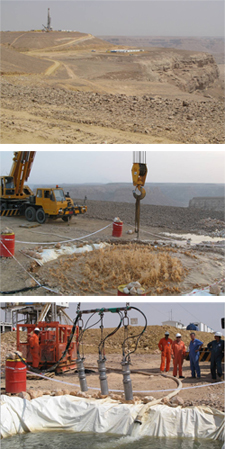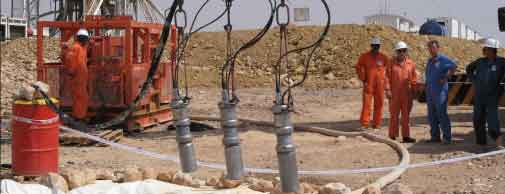



courtesy of Dove Energy Yemen

The primary purpose of Vertical Seismic Profiles is to establish the time-depth relationship at the well and obtain a character tie to the seismic. The major advantages of the VSP over the seismic are that VSPs are high bandwidth due to the one-way travel paths from source to receiver, and that the reflection data is known zero phase, since the downgoing wavefield is recorded and VSPs can therefore be deconvolved deterministically. Assuming a good VSP to seismic tie, the wavelet necessary to optimise the tie can be extracted to illustrate the phase and shift. Other uses of VSPs may include illumination of near-well geological features, shearwave information, AVO and anisotropy data, and frequency absorption analysis. The VSP can also be used as a prediction tool for deeper targets since reflected energy from below the wellbore is captured and this can be inverted to provide predicted velocity profiles below TD.
Survey types, in increasing degrees of complexity, include checkshot surveys, rig source VSP, vertical incidence VSP, fixed offset source VSP and Walkaway VSP. These may require 3D processing depending on the survey parameters. Pre-survey ray trace modelling can be undertaken to determine the optimum VSP survey configurations prior to data acquisition. Post-survey modelling may also be appropriate for many wells.
It is the policy of Upwave Limited to “give the client what he wants when he wants it”. As such a rapid turnaround is accompanied by some flexibility of data output. In addition to VSP processing, synthetic seismogram displays would typically be generated from the calibrated sonic and density logs, and the resultant synthetics and VSP data would be integrated with the seismic data supplied by the client. All data may be supplied as hard copies and digitally.
A typical set of VSP data processing deliverables for a rig source survey would include the following as a minimum, in addition to a fully documented text report containing interpretation and recommendations as appropriate;
It is the policy of Upwave Limited to “give the client what he wants when he wants it”. As such a rapid turnaround is accompanied by some flexibility of data output. In addition to VSP processing, synthetic seismogram displays would typically be generated from the calibrated sonic and density logs, and the resultant synthetics and VSP data would be integrated with the seismic data supplied by the client. All data may be supplied as hard copies and digitally.
A typical set of VSP data processing deliverables for a rig source survey would include the following as a minimum, in addition to a fully documented text report containing interpretation and recommendations as appropriate;
Survey review : Well plan, stacked VSP display, VSP, corridor stack and synthetic seismogram at seismic and maximum bandwidths, both bandwidth VSP corridor stacks inserted into the seismic inline and crossline, displays of migrated VSP inserted into the seismic if applicable, display of logs supplied, composite display of logs, synthetic, VSP corridor stack and seismic, both bandwidth synthetic seismograms inserted into the seismic inline and crossline. All displays to have tops annotated and any shifts clearly labelled.Additional services include
Intermediate VSP : T-D and F-K displays of three component data, upwave and downwave separation, T-D and F-K displays of deconvolved upgoing wavefield, enhanced deconvolved upgoing wavefield at seismic and maximum bandwidths, migrated VSP if applicable, VSP corridor stacks, attenuation analysis displays
Appendices : well velocity computations, time-depth, velocity and drift curves, time indexed data listing, formation tops listing, VSP acquisition details
Large scale enclosures :
1. Calibrated velocity and other logs at 1:500 linear depth scale.
2. Interpreters composite displays with log, synthetic seismogram, VSP and seismic data at 20cm/s.
VSP inversionClick here to download an overview of the VSProwess processing software
Q analysis
Seismic Wavelet extraction
Vp:Vs analysis
Shearwave imaging
Anisotropy analysis
AVO analysis
